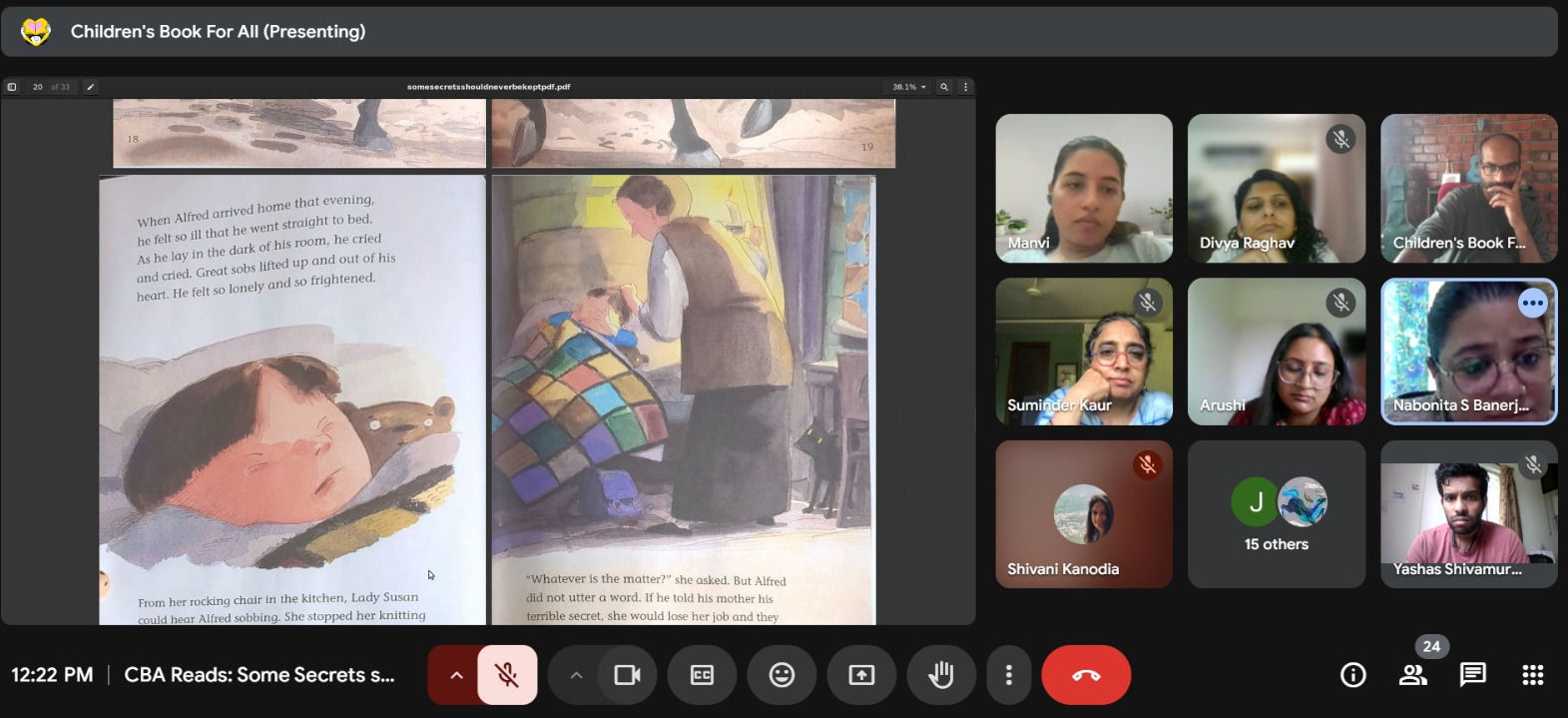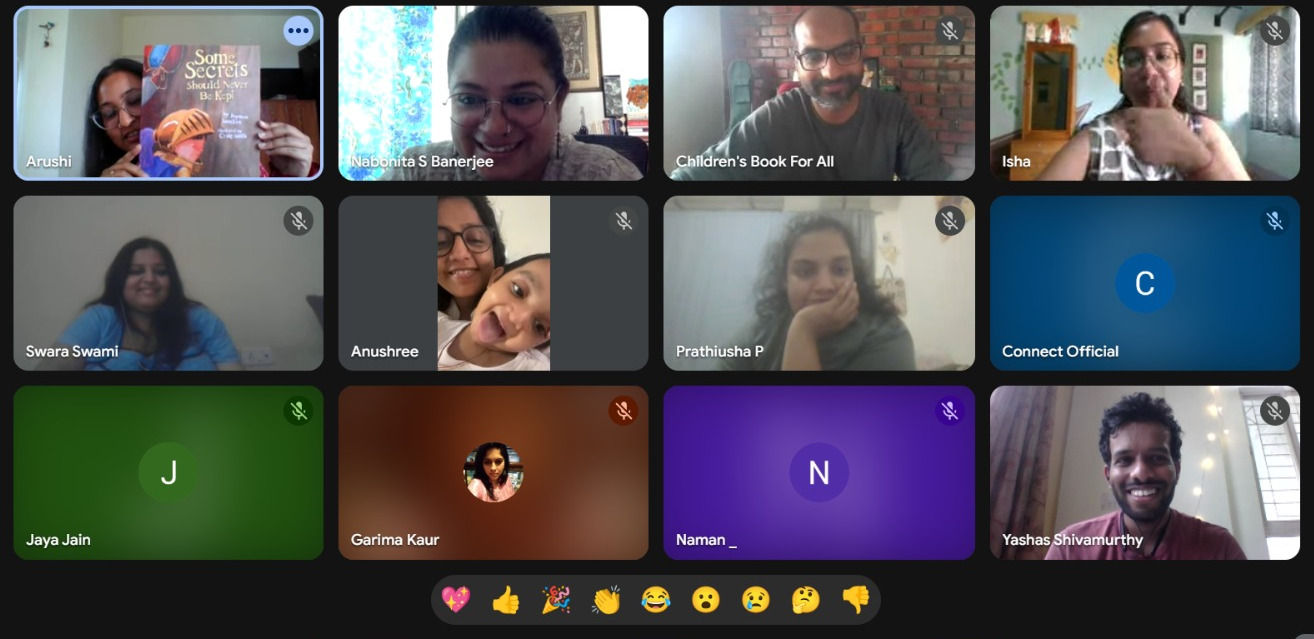Some Secrets Should Never Be Kept
 Manvi
Manvi  The Book: Some Secrets Should Never Be Kept
The Book: Some Secrets Should Never Be Kept
Session Overview
This session centered around a reading of the children’s book “Some Secrets Should Never Be Kept” by Jayneen Sanders, which addresses child sexual abuse prevention. The group engaged in a collective reading experience followed by personal reflections and discussions.
Session Guidelines and Disclaimers
The facilitators established important guidelines to create a safe and supportive environment for this sensitive discussion. Participants were reminded that the reading might evoke triggering experiences and were encouraged to practice self-care through grounding techniques such as sipping water, holding comfort objects, or stepping away if needed. Everyone was asked to use appropriate trigger warnings before sharing personal or graphic experiences. The facilitators emphasized creating a space for co-creating safety, holding, and connection for all participants, with each person free to share as much or as little as they felt comfortable with. The group agreed to refrain from offering unsolicited advice, fixing, or judgments when others shared their experiences unless explicitly requested. Confidentiality was highlighted as a collective responsibility that all participants were asked to uphold.
Participants’ Hopes and Intentions
At the beginning of the session, music was played and participants were asked to reflect on their personal intentions and hopes for the session. Many expressed a desire to be active listeners, to find camaraderie and solidarity with others in the space. Some spoke of wanting to hold space for everyone present, expressing love and standing in solidarity. Others mentioned their intention to disconnect from their internal worlds in order to connect more fully with those present in the session. One participant hoped to “meet any tightness with softness,” while another wished to hold space for themselves alongside others, allowing tears to flow naturally and committing to being fully present. Several participants mentioned wanting to process feelings as they emerged during the session.
 Book reading in a sensitive and caring space
Book reading in a sensitive and caring space
Book Reading and Reflections
The group read “Some Secrets Should Never Be Kept,” following the story of a young boy named Sir Alfred who experiences inappropriate touching by Lord Henry and eventually finds the courage to tell his mother. Throughout the reading, participants shared observations about the illustrations and the emotional undercurrents of the story. They noted the symbolic armor of the knight representing the boy’s attempt to be brave despite his vulnerability. Several participants commented on the relationship between the boy and his cat as a source of comfort and witness. The illustrations evoked observations about the boy appearing numb, with ominous shadows representing threats in the background. Many noticed the claustrophobic feel of the maze depicted in some scenes, symbolising the trapped feeling of the child’s situation. The group discussed the power dynamics portrayed in the story, with Lord Henry’s position and manipulative tactics clearly illustrated both in text and images. Participants reflected on how the perpetrator used guilt and blame against the child, coercing participation through blackmail and threats. The confusion created for children between what feels wrong and what adults tell them was a theme that resonated strongly with many participants. The physical manifestation of discomfort (“sick inside”) that Alfred experienced was highlighted as an important bodily response to violation. Participants also analysed the parental responses depicted in the story, noting the disconnect between mother and child despite their physical proximity. The initial dismissal of Alfred’s concerns (“Everyone loves Lord Henry”) sparked discussion about how children’s warnings are often overlooked. When Alfred’s mother finally listened and believed him, the group observed the profound relief and healing that began for the child. This highlighted the importance of adults creating space for difficult conversations and believing children when they share uncomfortable experiences.
“I never ever thought in my dream also that reading children’s book can be this much soothing and come with feeling of completeness.” - A reflection shared by a participant
Personal Sharing
Throughout the discussion, several participants courageously shared their own experiences, with appropriate trigger warnings. Some spoke of not having anyone to witness their discomfort as children, while others described the challenges of not having resources or vocabulary to understand what was happening to them. There were poignant reflections on experiences of being blamed or isolated after reporting abuse, which led to reluctance to speak up again. The cultural tendency for families to keep secrets within the home was mentioned, encapsulated in the phrase “Ghar ki baat ghar pe rahe” (home matters stay at home). Some participants reflected on how certain physical symptoms they experienced as children, such as bed-wetting or frequent illness, might have been manifestations of trauma that went unrecognized. The difficulty of identifying safe adults to confide in was a common thread in many stories. Several participants shared the confusion they felt as children, not knowing whether they would be believed if they spoke up, and fearing that telling might harm their loved ones. The profound loneliness that abuse creates, even when physically surrounded by family members, was described as a particularly painful aspect of these experiences.
Closing Activity: Lending Our Voices
Toward the end of the session, participants were invited to explore several questions through photography or writing in an activity called “Lending Our Voices.” They were asked to consider what safety looks like for them personally, and how their body, heart, and soul feel when holding information or secrets that nobody else is witnessing. The questions also prompted reflection on acts of resistance or self-protection during difficult times, and what shifts occur when vulnerability is revealed to someone who holds it safely. Finally, participants were invited to imagine what they might offer if they met Alfred, their little child self, Alfred’s mother, or Henry. As participants began to engage with these reflective questions, they shared initial thoughts about safety looking like quiet spaces, gardens, or “me time.” Some mentioned the importance of light, symbolized by a diya (oil lamp), in creating feelings of security. The questions appeared to open space for deeper personal reflection that would continue beyond the session itself.
 CSA Survivors and Allies
CSA Survivors and Allies
This reading was facilitated by Nabonita S Banerjee and Arushi Ralli
You can register for our upcoming readings here